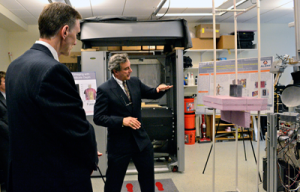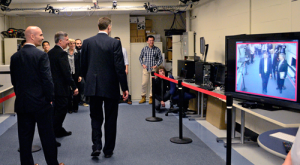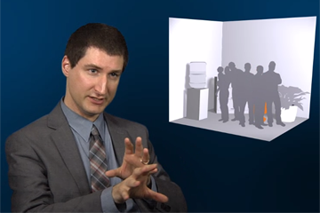News & Events
ALERT Program
ALERT 101 is Back! July 17, 2013
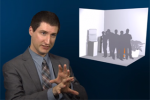
ALERT 101: Video Analytics
We are pleased to present the second installment of ALERT 101. This segment’s topic is Video Analytics. ALERT researchers Richard Radke, Octavia Camps, and Venkatesh Saligrama explain what it is, how it’s used, and how they teach computers how to see and learn.
For users without YouTube access: ALERT 101: Video Analytics
This material is based upon work supported by the U.S. Department of Homeland Security under Award(s) 2008-ST-061-ED0001 and/or 2008-ST-061-ED0002. The views and conclusions contained in this document are those of the authors and should not be interpreted as necessarily representing the official policies, either expressed or implied of the U.S. Department of Homeland Security
Inspired by the success of TED (www.ted.com) and other educational media forums, ALERT has developed the ALERT 101 video series. Each video short features different technologies and research areas that the ALERT Center engages in. We hope that these productions help educate and inform the global community on these topics in an accessible and enjoyable way.
ALERT hosts TSA Administrator, John Pistole and Boston Air Security Officials at NEU June 18, 2013

On June 12th, 2013, the ALERT Center at Northeastern University hosted a visit by the Transportation Security Administration (TSA) Administrator, John Pistole, along with acting Boston Field Office Supervisory Air Marshal, David Brown, Boston Logan International Airport Federal Security Director, George Naccara and Kenneth Fletcher, Senior Advisor to the Deputy Administrator at TSA.
The visit was led by the Deputy Director of ALERT, Professor Carey M. Rappaport and included a tour of the Advanced Imaging Technology (AIT) lab where a group of 20 undergraduate and graduate students participated in demonstrations of ALERT research projects, including Multistatic Millimeter-Wave AIT scanning and Real-Time High-Value 3D External Surface Imaging using the X-Box Kinect sensor.
Professor Rappaport also presented his Standoff Detection Experiment, which uses a powerful millimeter-wave radar unit to detect threats from a distance, such as concealed body-worn explosives.
The tour continued in the Video Analytics Lab run by ALERT Professors Octavia Camps and Mario Sznaier. Using cameras and monitors, Professors Camps and Sznaier, along with their students, staged the lab to look like an airport exit lane, and asked Administrator Pistole and his associates to participate in a demonstration of the lab’s Video Analytic Surveillance Transition (VAST)software. The demonstration showed how their software flags “counter-flow” activity, by detecting people who walk “in” through an “exit” lane, thereby alerting security personnel if a person attempted to bypass a TSA checkpoint. Similar software is used for identifying left objects, which was demonstrated by the team when another program flagged a backpack which was left on the ground by a student walking through a crowd.
The visit was an excellent opportunity to present both ALERT research, and other security research that is being done at Northeastern University to Administrator Pistole and his group.
ALERT and Los Alamos National Laboratory (LANL) Receive $750,000 DARPA Award May 16, 2013
ALERT and Los Alamos National Laboratory have received a $750,000 DARPA award for their partnership in Nuclear Magnetic Quadrupole Resonance research. Their proposal was submitted and accepted for the Methods for Explosive Detection at Standoff (MEDS) program. This project will be led by Prof. Carey Rappaport, the Principal Investigator from Northeastern University, and partner lead, Michelle Espy, from LANL.
ALERT Co-Director Provides Insight on Marathon Bombing Devices April 20, 2013

ALERT Co-Director Jimmie Oxley speaks with Rhode Island News Team 10 about the type of explosive devices used in the Boston Marathon Bombings.
Pressure cooker bombs, like the ones reportedly used in the explosions near the finish line at the Boston Marathon, are a common and simple way to make an explosive device, according to a University of Rhode Island chemistry professor.
“It only takes a small amount of black powder to ignite a powerful blast,” said Jimmie Oxley, who also is a member of the U.S. Department of Homeland Security Center for Excellence for Explosives, Detection, Mitigation and Response.
She said if you put it inside a common kitchen pressure cooker, you’ll have a weapon. The steel container will make fragments which are what do the most damage.
“If you feel the sharpness of those edges, if that hits you, you can see why it takes off an arm. If it was a pressure cooker, it would create frag,” Oxley said.
Oxley said of all terrorist weapons, a homemade bomb is the most accessible…
Read More2013 ALERT REU Summer Program Now Accepting Applications January 16, 2013
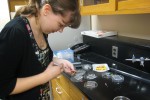
We are accepting applications for the upcoming ALERT REU Program. The 10-week paid summer program offers undergraduate engineers the opportunity to engage in ALERT research with faculty members located at Northeastern University in Boston, Texas Tech University in Lubbock, and the University of Puerto Rico in Mayagüez. The application deadline is February 22, 2013. For more information, and to apply, visit the REU webpage.
Read MoreFollow-on Funding Awarded to Dr. Conrad Jones January 16, 2013

Dr. Conrad Jones, a faculty member at Southern University, was awarded $50,000 of follow-on funding through the DHS Summer Research Team Program for MSIs. Dr. Jones was originally chosen to participate in the program during the summer of 2012 to work on ALERT research with Profs. Louisa Hope-Weeks and Brandon Weeks at Texas Tech University.
At the end of the summer, faculty participants are encouraged to apply for up to $50,000 in follow-on funding to continue the research collaboration at their home academic institutions during the following academic year.
Congratulations Dr. Jones!!!
(Photo Source: https://www.orau.gov/dhseducation/)
David Castanon discusses ALERT-related research December 6, 2012
Watch Professor Castanon talk about his work in luggage screening, video analytics and explosives detection with the National Science Foundation:
ALERT Researcher Carey Rappaport discusses his work with Northeastern University November 28, 2012
Watch Professor Rappaport talk about his Homeland Security Related Research with Northeastern University:
ALERT Researcher Jose Martinez is awarded the Best Paper Award at HST ‘12 November 20, 2012
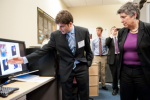
Assistant Professor Jose Martinez was awarded the Best Paper Award at the 2012 IEEE Conference on Technologies for Homeland Security (HST ’12). The award was given for his paper entitled, “A Compressed Sensing Approach for Detection of Explosive Threats at Standoff Distances using a Passive Array of Scatters”.
The twelfth annual IEEE Conference on Technologies for Homeland Security (HST ’12), was held 13-15 November 2012 in Greater Boston, Massachusetts. This year’s conference showcased selected technical papers and posters highlighting emerging technologies in the areas of:
- Cyber Security,
- Attack and Disaster Preparation, Recovery, and Response,
- Land and Maritime Border Security
- Biometrics & Forensics.
The conference brought together innovators from leading universities, research laboratories, Homeland Security Centers of Excellence, small businesses, system integrators and the end user community and provided a forum to discuss ideas, concepts and experimental results.
ALERT welcomes United States Secretary of Homeland Security, Janet Napolitano November 19, 2012

Awareness and Localization of Explosives-Related Threats was pleased to host U.S. Secretary of Homeland Security, Janet Napolitano on Monday, November 12th following her keynote address at Northeastern University’s Veteran’s Day Ceremony.
To kick off the visit, ALERT’s Director, Professor Michael B. Silevitch, provided Secretary Napolitano with an overview of the ALERT Center of Excellence. Prof. Silevitch then introduced undergraduate and graduate students involved with ALERT research and gave a summary of the demonstrations in video analytics and advanced imaging technologies that were prepared for her briefing. Michael described Napolitano’s visit as a significant opportunity for ALERT and its homeland security research, saying,
“It was very important to get validation from Secretary Napolitano about the relevance of our research and its transition to the field in the areas of video tracking of threats and passenger screening. This acknowledgement inspires us.”
Professor Octavia Camps led the first demonstration featuring ALERT’s Engage to Excel (E2E) Video Analytic Surveillance Transition project, VAST. VAST is a program developed in partnership with Siemens and the Cleveland Transportation Security Administration. The live demonstration exhibited the video analytic counter-flow program developed by Dr. Camps and her team and its ability to automatically detect when a person is proceeding the wrong way in an identified traffic pattern (for example, trying to enter through an exit). The resulting detections enable quick identification of an incident and minimize the impact on TSA resources. This project is currently installed within the Cleveland Hopkins International Airport.
Following the video analytics demonstration, Professor Carey Rappaport showed Secretary Napolitano the capabilities of the ALERT Advanced Imaging Technologies (AIT) laboratory. This laboratory fuses together various scanning tools to create next-generation security scanning systems. Professor Rappaport, Assistant Professor Jose Martinez and graduate student Spiros Mantzavinos demonstrated the operation and data acquisition capabilities of ALERT’s advanced portal-based millimeter-wave imaging radar. During the demo, the system scanned a mannequin wrapped in a skin simulant with various representative objects attached for detection. These types of AIT systems can be used to detect illicit items that passengers may be attempting to carry on their person.
“As a DHS-supported researcher, I found Secretary Napolitano’s visit very satisfying,” Prof. Rappaport commented. “She was of course quite knowledgeable about the science and technology we are pursuing, but she seemed keenly interested in how we were improving the state of the art. She was completely supportive and she motivated the students with her passion to keeping Americans safe.”
Spiros Mantzavinos, currently a Northeastern University Doctoral Candidate in Electrical and Computer Engineering and Gordon Engineering Leadership Fellow, had the opportunity to meet Secretary Napolitano. Mantzavinos said, “It was an honor to host Secretary Napolitano for a visit to our ALERT whole-body imaging lab. Receiving attention and recognition from such a prominent figure in the national security arena assures the relevance of the advances we are making.”

